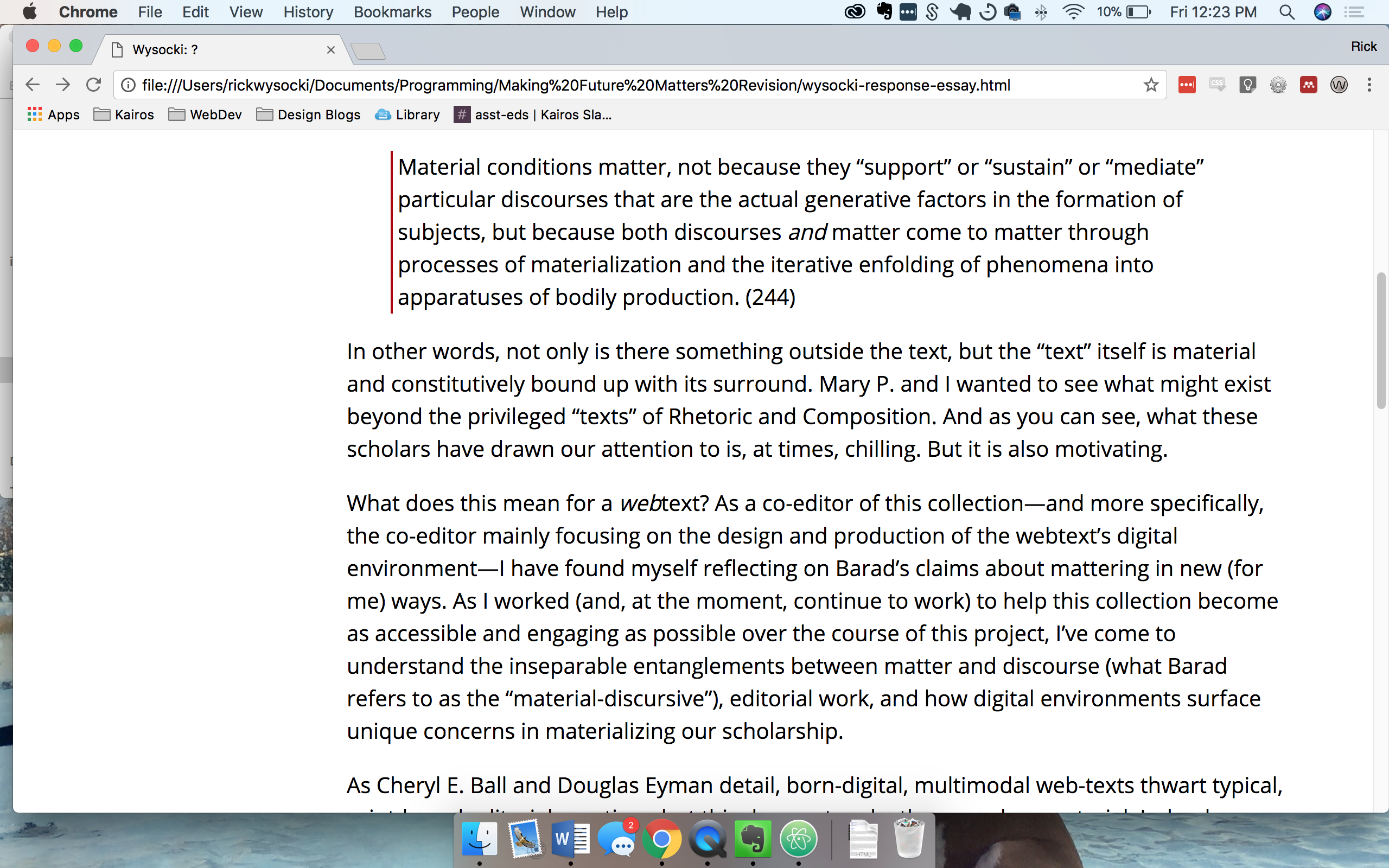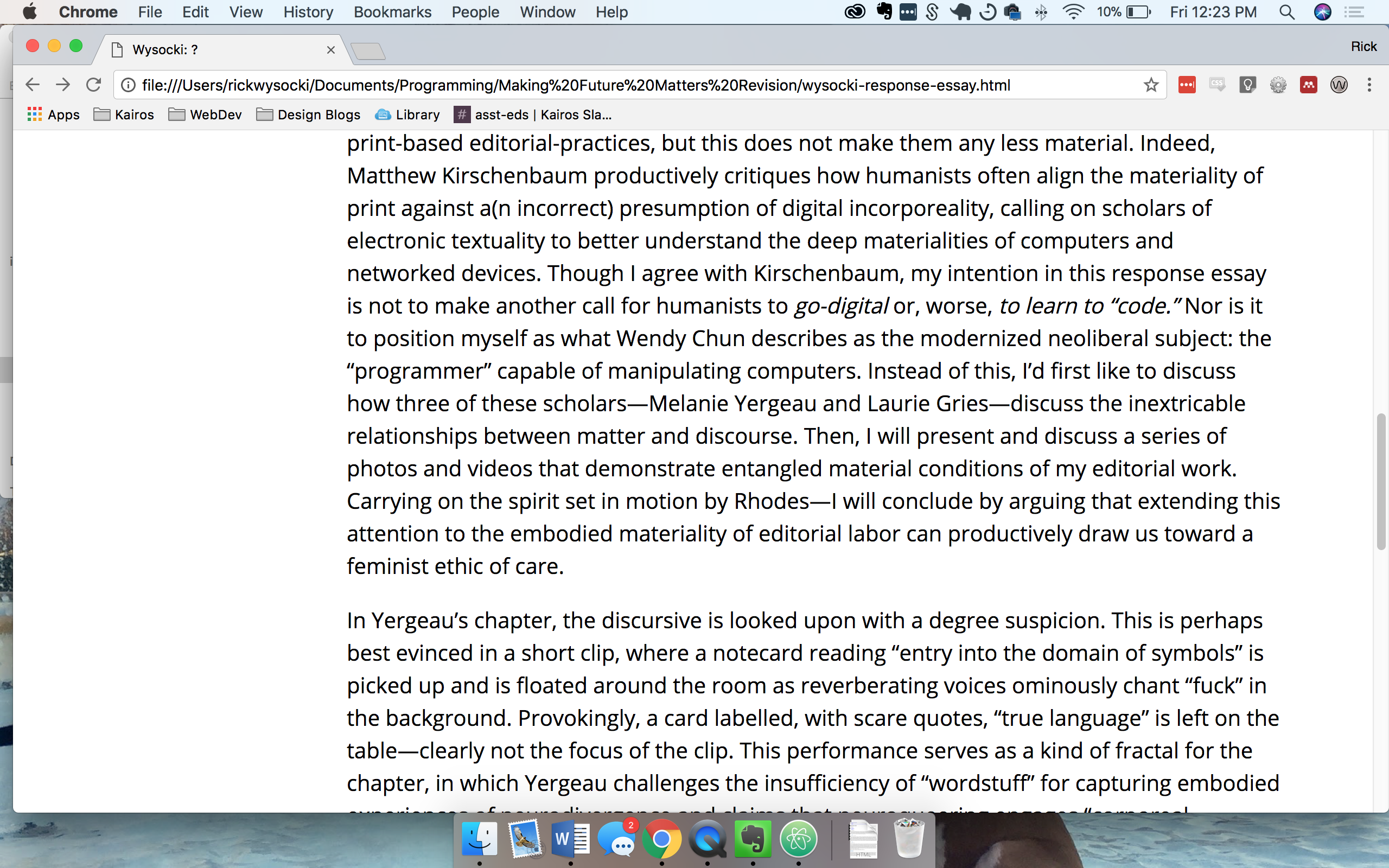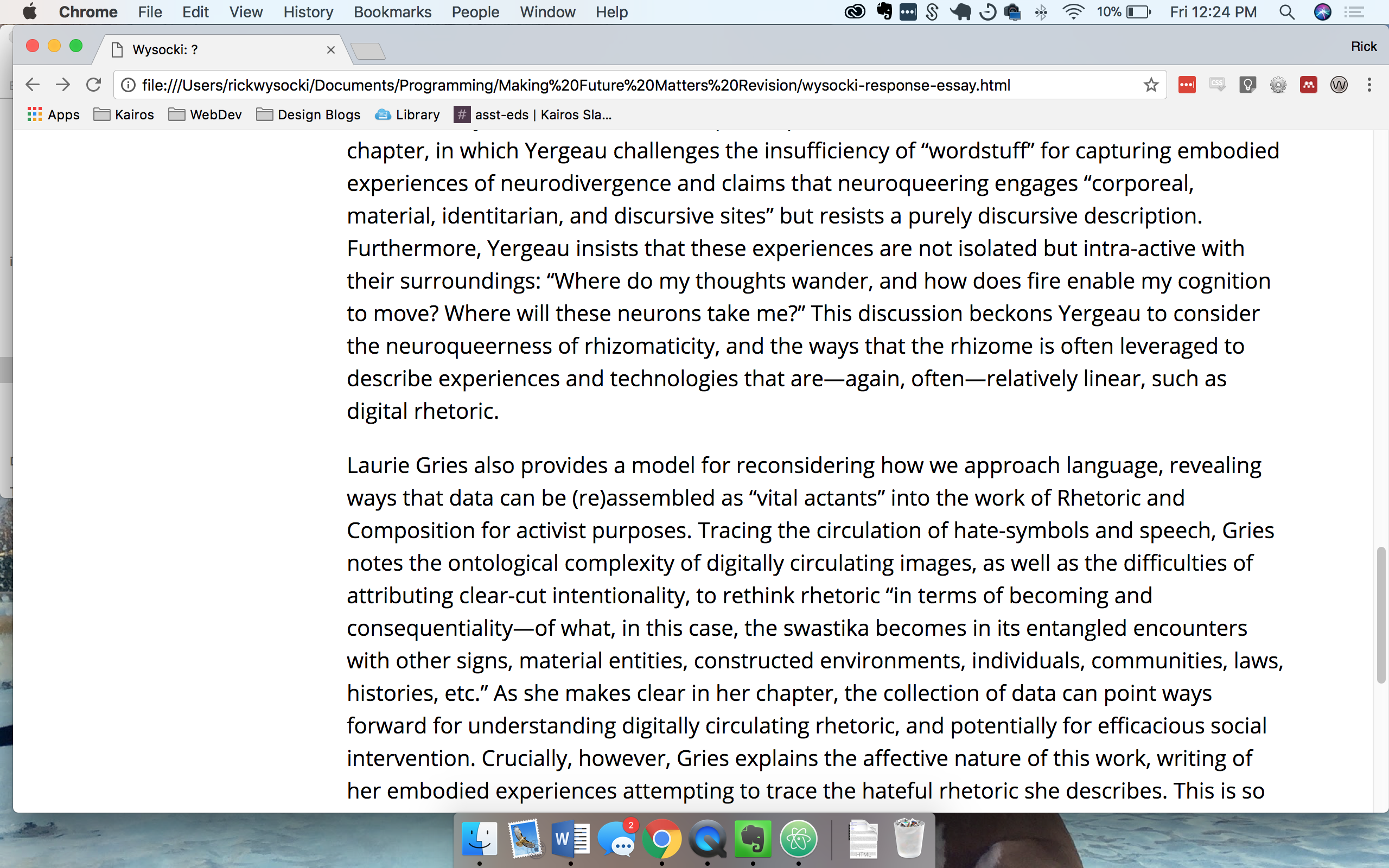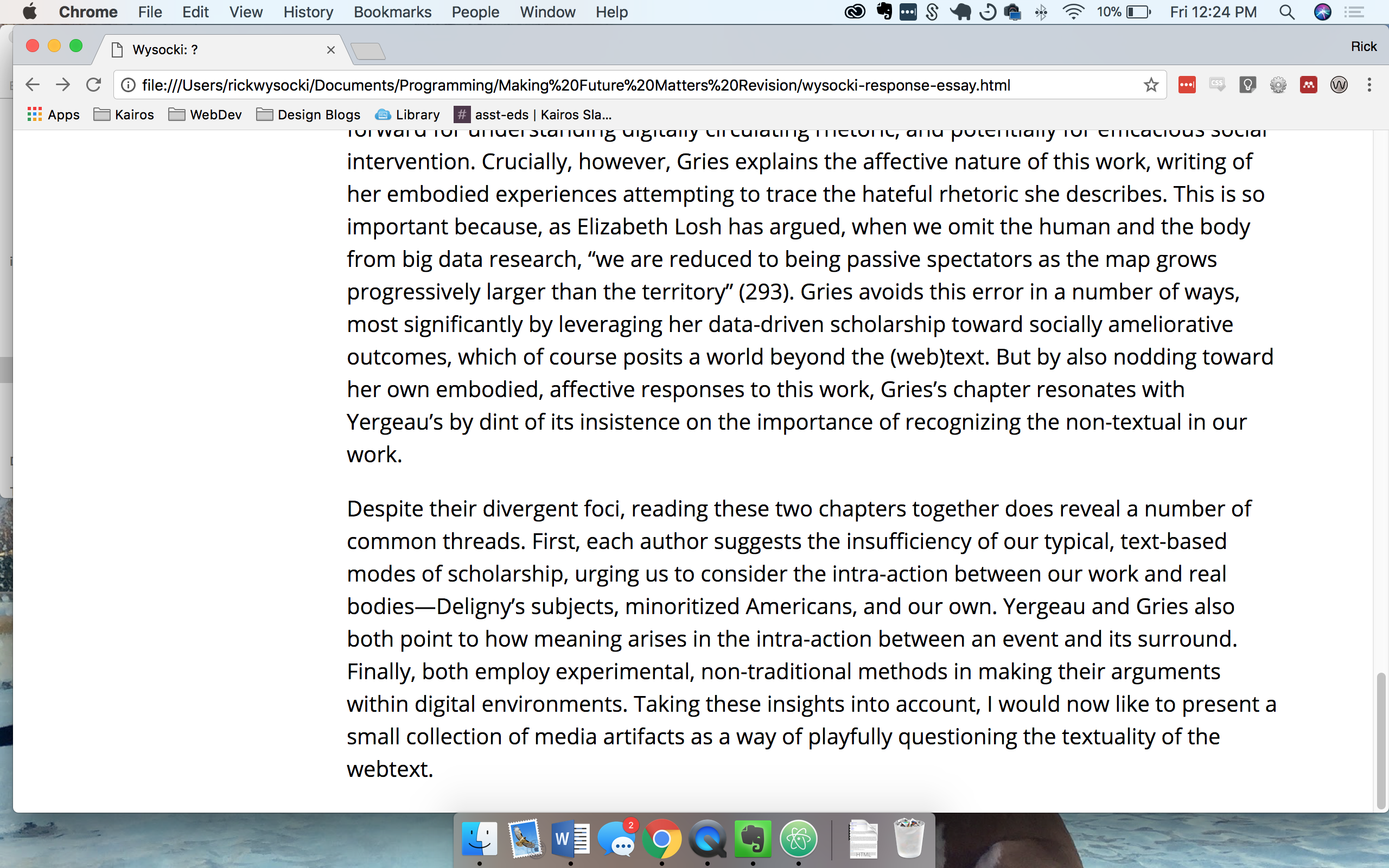Abstract
Extending the work of Yergeau, Gries, and Rhodes in this collection, this response essay considers how a new materialist conception of entanglement can inflect ideas regarding digital composing and editorial work.
I.
As a co-editor of this collection—and more specifically, the co-editor focusing on the design and production of the webtext’s digital environment—I have found myself reflecting on Karen Barad’s claims about mattering as discussed in the collection’s introduction and throughout its chapters in new (for me) ways. As I worked (and at the moment continue to work) to help create an accessible and engaging collection, I’ve come to understand the inseparable entanglements between matter, discourse, embodiment, and editorial labor, as well as how digital environments surface unique concerns in materializing our scholarship. We often—not always—think about digital artifacts in terms of textuality and/or discursivity: we refer to them as webtexts, talk about their sometimes unique affordances for meaning-making, and discuss their markup and even the need to learn to code. But because the materiality of a digital artifact has literal effects on the inclusion and exclusion of audiences, it makes rhetorical sense to consider a digital artifact not in terms of textuality but rather as a “material-discursive phenomenon,” a term Barad uses to signal the intra-activity and inseparability between matter and discourse (150). Serving as a microcosm for debates between new materialist and poststructural orientations, such a perspective foregrounds embodiment and materiality over an all-encompassing notion of the “text.”
As Matthew Kirschenbaum notes, textual and discursive approaches to new media have often led humanists to juxtapose the materiality of print against a(n incorrect) presumption of digital incorporeality, calling on scholars of electronic textuality to better understand the deep materialities of computers and networked devices. He writes of a “medial ideology” that suffuses much scholarship on new media, where the actual functioning of technologies is ignored and “digital” becomes seen as immaterial, instantaneous, and detached from time and space. Angela Haas, more well-known in our field, also productively argues for the embodied materiality of writing by considering that, in an important sense, all writing is digital since digital “refers to our fingers, our digits, one of the primary ways (along with our ears and eyes) through which we make sense of the world and with which we write into the world” (84). While I use “digital” in this essay in the familiar sense to refer to technologies that encode and decode data using binary logics, I am more interested in a question that emerges from reading together Kirschenbaum, Haas, and the essays in this collection than I am about digital technologies themselves: in what ways might we foreground embodiment and materiality to resist considering a webtext in purely textual terms?
With this guiding question in mind, I’ll first discuss how two chapters in this collection—those by Melanie Yergeau and Laurie Gries—reach beyond the typical discursive practices of our field. Then, I will present and discuss a series of photos and videos, an experimental “think practice” (to use the term taken up by Jacqueline Rhodes) that playfully speculates on the entangled material and embodied conditions of my own editorial work. In doing so, I will ultimately suggest that extending a speculative attention to embodiment and materiality can orient us toward a productive, new materialist-informed approach to considering digital artifacts.
II.
Yergeau examines discourse suspiciously. This suspicion is perhaps best evinced in a short clip, where a notecard reading “entry into the domain of symbols” is picked up and floated around the room as reverberating voices ominously chant “fuck” in the background. Provokingly, a card labeled, with scare quotes, “true language” is left on the table—clearly not the focus of the clip. This performance exists as a thematic fractal of the chapter, in which Yergeau challenges the insufficiency of “wordstuff” for capturing embodied experiences of neurodivergence and claims that neuroqueering engages “corporeal, material, identitarian, and discursive sites” but resists a purely discursive description. Furthermore, Yergeau insists that these experiences are not isolated but intra-active with their surroundings, asking, “Where do my thoughts wander, and how does fire enable my cognition to move? Where will these neurons take me?” Yergeau beckons us to consider the neuroqueerness of rhizomaticity and the ways that the rhizome is often leveraged to describe experiences and technologies that omit or efface embodied disability.
Laurie Gries also provides a model for reconsidering how we approach our work, revealing ways that data can be (re)assembled as “vital actants” into Rhetoric and Composition for activist purposes. Tracing the circulation of hate-symbols and speech, Gries notes the ontological complexity of digitally circulating images as well as the difficulties of attributing clear-cut intentionality. She rethinks rhetoric “in terms of becoming and consequentiality—of what, in this case, the swastika becomes in its entangled encounters with other signs, material entities, constructed environments, individuals, communities, laws, histories, etc.” As she makes clear in her chapter, data collection can point to ways of understanding digitally circulating rhetoric, potentially for efficacious social intervention. Crucially, however, Gries explains the affective nature of this work, writing of her embodied experiences attempting to trace the hateful rhetoric she describes. This acknowledgement is so important because, as Elizabeth Losh has argued, when we omit the human and the body from big data research, “we are reduced to being passive spectators as the map grows progressively larger than the territory” (293). Gries avoids this error in a number of ways, most significantly by leveraging her data-driven scholarship toward socially ameliorative outcomes, which of course posits a world beyond the (web)text. But by also nodding toward her own embodied, affective responses to this work, Gries’s chapter resonates with Yergeau’s by dint of its insistence on recognizing the non-textual aspects of doing scholarship.
Despite their divergent foci, reading these two chapters together does reveal a number of common threads. First, each author suggests the insufficiency of our typical text-based modes of scholarship, urging us to consider the intra-action between our work and real bodies—Deligny’s subjects, oppressed and minoritized humans, and our own. Yergeau and Gries also both point to how meaning arises in the intra-action between an event and its surround. Finally, both employ experimental, non-traditional methods in making their arguments within digital environments. As I thought through these considerations, I began to wonder in what other ways the body could be made visible in digital rhetorical production or, in my case, digital editorial labor. Taking on this question, I now present a small collection of media artifacts as a way to playfully question the textuality of this particular webtext.
III.
In new media studies, there is an extant debate regarding the nature of digital materiality. In fact, I would argue that this is a primary question of all inquiries into new media. Is a YouTube video, for example, a remediated “film” that circulates—with material, social, and economic consequences—to diverse audiences across the world? Is it a collection of ones and zeroes that are decoded and recomposed by the physical processes of networked computers? Is it a mode and/or medium of meaning-making with unique affordances for communication? Or could it be a conveyor of content that triggers material, embodied responses on the part of viewers? All of these are, of course, true—but it is surprisingly vexing to attempt to consider them all at once.
The media philosopher Yuk Hui has referred to the various modes of digital existence as comprising different orders of magnitude. Rather than necessarily choosing one or another, Hui argues that a digital object exists at different orders of magnitude and proposes that an efficacious digital philosophy would "set up a line of thought, incorporating both technical and philosophical thinking, that bridges the different realities of a digital object" (32). For Hui, this necessitates a political orientation focused on developing a more robust digital culture by "search[ing] for different modes of reticulation and convergence" (4) between digital objects and their various orders of magnitude. I will return to these rather large concepts, but to illustrate the orders of magnitude of a digital object, consider the following two images.


These are screenshots of an HTML file. They represent a version of this essay, a snapshot of a becoming. It is formatted according to a fairly stringent set of syntactic and semantic rules and guidelines that, if broken, would likely render the page unreadable in a browser. This document is not rhizomatic—it relies on hierarchy and linearity. But this is not its only form.





These images show the exact same markup but displayed in a web browser. Clearly this text is linear, but in a different fashion. It allows for exploration, clicking links, moving to other chapters, and many other interactions that are not taken advantage of in this simple page. However, both these images are incomplete. By stabilizing the webtext at two static orders of magnitude, these images dehistoricize the digital object and enter it something similar to what Lisa Gitelman refers to as the “continual, continuous present” of the Internet (145). The following video attempts to disrupt this stabilization.
This is a sped-up recording of my computer screen as I transcode a version of this essay into HTML format. I begin by formatting a new HTML file, taking a page I’d previously created for the collection, and revising it to become my essay. At the 1:25 mark of the video, I begin to cross-check the markup across two orders of magnitude (the markup and its display in a browser), and I notice a problem: the page header including my title (in this version a simple “?”) and my name is broken. I attempt to fix this problem, figuring it out at the 2:27 mark. I move on to finishing encoding the content from my Word file, which includes making sure the italicized portions are encoded with <em> tags for emphasis or <i> tags for simply setting text apart, which increases their semantic meaning for individuals using screen-readers to listen to the chapters. But there is still the striking absence of embodiment and affect. So, a final video.
This video reflects yet another order of magnitude, but rather than focusing on the technical aspects of digital editorial work, you can now see my own embodied activity as I intra-act with the various technologies and tools in the earlier images and videos. You see my puzzled expressions from 1:25 to 2:28 as I notice and attempt to fix the problem in the page header; you see me repeatedly play with my beard and put my mouth to my hand as I think; you see me lean back to make sure that my dog is still sleeping on my couch. All of these phenomena, including the HTML markup I am writing as depicted in the screen recording (also inseparable from the embodied activities shown in the second video), are entangled and intra-acting, calling attention to the ways that digital artifacts exceed textuality and instead emerge by way of entanglements—of bodies, technologies, and a host of other intra-acting forces. Digital artifacts, and digital scholarship for that matter, fundamentally reflect the inextricable relationship between matter and meaning. They are material-discursive phenomena.
IV.
As I indicated above, if we take Yergeau and Gries’s work as models for making future matters in our work, then materiality, embodiment, and the need to include non-traditional scholarly methods and paradigms are guiding themes. In the above section, I engaged in a very small-scale “think-practice” in order to speculate on what reinscribing embodiment into my own editorial work might look like. My point in presenting these materials was to highlight how webtexts are always entangled in and among a diverse array of bodies, technologies, and digital orders of magnitude, as well as how the role of digital editorial work is to help materialize digital objects as intentionally and accessibly as possible while recognizing the uncertainties of digital circulation.
The affordances of webtexts and of digital composition generally are often discussed in terms of their ability to circulate in different and sometimes wider ways that print texts. A corollary to this affordance, however, is that digital artifacts circulate in often unexpected ways and therefore require strategies for anticipating such circulation (Ridolfo and DeVoss). Indeed, digital artifacts unexpectedly enact what Rhodes in this collection refers to as rhetoric as instantiation, “the ongoing, fleeting intersections of language, body, and network that reveal what Karen Barad has called our ‘relationalities of becoming.’” While Rhodes focuses specifically on the concept in relation to queer rhetoric, this perspective can speak to how we understand digital rhetoric and artifacts more broadly. In the “think practice” above I attempted to illustrate certain aspects of the material entanglements that helped to comprise this book: the human body, digital technologies, and my surroundings as I carried out a small portion of editorial labor. While this is only a tiny sliver of the various entanglements that inform this collection, attending to them helps me to speculate uncertainly on the bodies, technologies, surroundings, and worlds toward which a digital artifact might travel.
Knowing that a webtext is never a purely textual phenomena calls us to rethink how we might approach a “digital culture,” as Hui refers to it. Developing a robust digital culture, and certainly digital rhetoric, requires a speculative intentionality, a knowingness that though digital artifacts circulate and entangle in unexpected ways we must consider them first and foremost as material forces that act in and on the world. Such a disposition has benefits not only for considering accessibility—though certainly that—but also for foregrounding an attention to embodied and material consequentiality in our work, however speculative that attention may (necessarily) be.
Works Cited
- Ball, Cheryl and Douglas Eyman. "Editorial Workflows for Multimedia-Rich Scholarship. Journal of Electronic Publishing, vol. 18, no. 4, 2015.
- Barad, Karen. Meeting the Universe Halfway: Quantum Physics and the Entanglement of Matter and Meaning. Duke UP, 2007.
- Gitelman, Lisa. Always Already New: Media, History and the Data of Culture. MIT P, 2006.
- Haas, Angela M. "Wampum As Hypertext: An American Indian Intellectual Tradition of Multimedia Theory and Practice." Studies in American Indian Literatures, vol. 19, no. 4, 2008, pp. 77–100.
- Hui, Yuk. On the Existence of Digital Objects. U of Minnesota P, 2016.
- Kirschenbaum, Matthew G. Mechanisms: New Media and the Forensic Imagination. MIT P, 2012.
- Losh, Elizabeth. "Nowcasting/Futurecasting: Big Data, Prognostication, and the Rhetorics of Scale." Rhetoric and the Digital Humanities. Eds. Jim Ridolfo and William-Hart Davidson. U of Chicago P, 2015.
- Ridolfo, Jim and Dànielle Nicole DeVoss. "Composing for Recomposition: Rhetorical Velocity and Delivery." Kairos: A Journal of Rhetoric, Technology, and Pedagogy, vol. 13, no. 2. 2009. http://kairos.technorhetoric.net/13.2/topoi/ridolfo_devoss/velocity.htm
